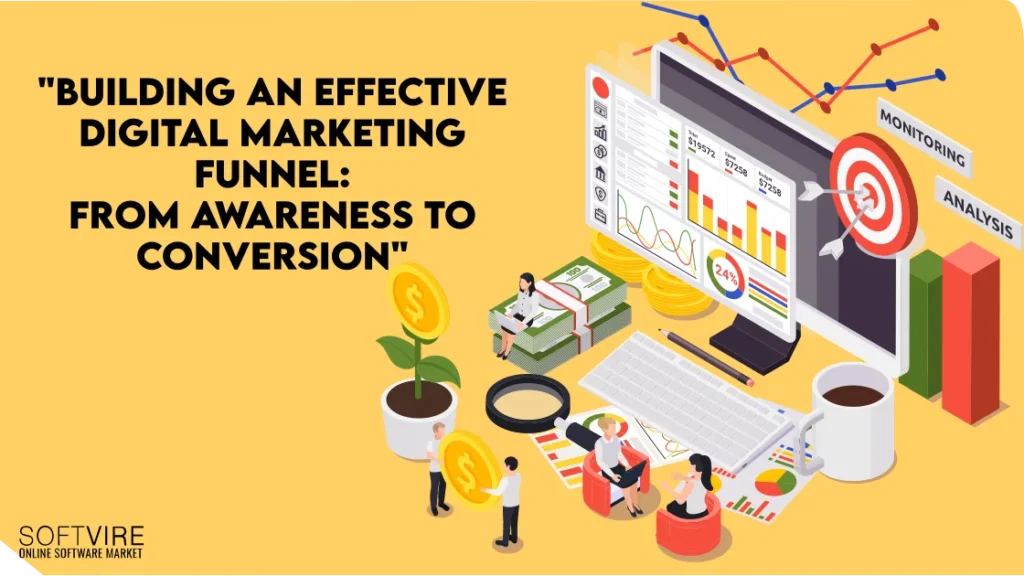I. Introduction
A. Definition of a digital marketing funnel
In this section, you can explain a digital marketing funnel. It is a framework representing the consumer journey that begins with first becoming aware of a product or service to the final conversion or purchase.
B. Importance of an effective digital marketing funnel
Here, you can highlight the significance of having an effective digital marketing funnel. It helps businesses systematically guide potential customers through the buying process, increasing the likelihood of conversion and customer loyalty.
II. Stage 1: Awareness
A. Understanding the target audience
This subsection discusses the importance of understanding the target audience’s demographics, interests, and pain points. This knowledge helps in creating effective marketing strategies to capture their attention.
B. Developing a compelling brand message
Explain the need for a compelling brand message that resonates with the target audience. Discuss the critical elements of a strong brand message, such as clarity, differentiation, and value proposition.
C. Implementing effective content marketing strategies
Here, outline various content marketing strategies that can be used to create awareness:
- Creating engaging blog posts and articles: Explain the importance of creating valuable and informative content to attract and engage the target audience.
- Utilizing social media platforms for brand awareness: Highlight the power of social media in reaching a wider audience and building brand awareness.
- Leveraging search engine optimization (SEO) techniques: Discuss the significance of optimizing website content to improve search engine rankings and increase visibility.
D. Generating leads through lead magnets and gated content
Explain the concept of lead magnets and gated content as practical strategies to capture leads during awareness. Discuss the types of lead magnets, such as e-books, whitepapers, or webinars, and the importance of exchanging contact information. You will receive excellent content.
III. Stage 2: Interest
A. Nurturing leads with email marketing campaigns
Discuss the importance of email marketing in nurturing leads and creating a relationship with future consumers. Highlight the need for personalized and relevant content to keep leads engaged.
B. Providing valuable and relevant content to build trust
Emphasize providing valuable and relevant content to keep the leads interested in the brand. Discuss using blog posts, case studies, videos, and other forms of content to establish expertise and credibility.
C. Personalizing the user experience through targeted advertising
Explain the significance of targeted advertising to reach the leads with personalized messages and offers. Discuss methods such as behavioral targeting, demographic targeting, and retargeting to increase the relevance and effectiveness of advertisements.
D. Implementing retargeting strategies to re-engage potential customers
Retargeting techniques, such as displaying ads to users who have previously shown interest in the brand, bring back potential customers who might have left the conversion path. Highlight the importance of reminding them about the brand and its value proposition.
IV. Stage 3: Decision
A. Building credibility through customer testimonials and reviews
Explain the role of customer testimonials and reviews in building trust and credibility. Discuss the importance of showcasing positive feedback and addressing any negative reviews promptly and professionally.
B. Utilizing persuasive landing pages and product demonstrations
Discuss the significance of persuasive landing pages and product demonstrations to convince leads to purchase. Highlight the importance of clear and compelling messaging, strong call-to-action buttons, and visually appealing design.
C. Implementing remarketing tactics to encourage decision-making
Explain how remarketing can be used to target leads who have shown interest but have yet to convert. Discuss methods such as offering limited-time discounts or free trials to create a sense of urgency and encourage decision-making.
D. Simplifying the purchasing process for customers
Highlight the importance of a streamlined and user-friendly purchasing process. Discuss the need for a straightforward and intuitive checkout process, multiple payment options, and transparent shipping and return policies.
V. Stage 4: Action/Conversion
A. Optimizing the checkout process for a seamless user experience
Explain the importance of optimizing the checkout process to minimize friction and improve the customer experience. Discuss the need for a mobile-friendly interface, guest checkout options, and progress indicators to enhance conversion rates.
B. Offering incentives and discounts to encourage immediate action
Discuss the effectiveness of offering incentives and discounts to incentivize immediate action and increase conversion rates. Highlight the importance of limited-time offers, exclusive discounts, and freebies.
C. Utilizing persuasive call-to-action (CTA) buttons and messaging
Explain the significance of persuasive call-to-action buttons and messaging to guide users toward conversion. Discuss using action-oriented language, contrasting colors, and strategic placement of CTAs to increase click-through rates.
D. Implementing effective follow-up strategies to increase customer retention
Discuss the importance of post-conversion follow-up strategies to ensure customer satisfaction and encourage repeat business. Highlight personalized thank-you emails, loyalty programs, and ongoing customer support.
VI. Stage 5: Advocacy
A. Encouraging customer feedback and reviews
Discuss the importance of actively encouraging customers to provide feedback and reviews. Explain how positive reviews and testimonials can influence other potential customers and enhance brand reputation.
B. Implementing referral programs to incentivize word-of-mouth marketing
Explain the benefits of referral programs in encouraging customers to refer their friends and acquaintances. Discuss using incentives, such as discounts or rewards, to motivate customers to become brand advocates.
C. Engaging with customers through social media and online communities
Discuss the significance of engaging with customers through social media platforms and online communities. Highlight the importance of responding to comments, addressing concerns, and fostering a sense of community around the brand.
D. Providing excellent customer service and support
Stresses the significance of outstanding customer service and support. Discuss the role of timely and personalized responses, efficient issue resolution, and ongoing communication in building customer loyalty and advocacy.
Conclusion
In conclusion, building an effective digital marketing funnel is crucial for guiding potential customers from awareness to conversion. It involves understanding the target audience, developing a compelling brand message, and implementing various strategies at each stage of the funnel.
Every stage plays a vital role in creating awareness through content marketing and lead generation, nurturing leads, building trust, and facilitating decision-making. Simplifying the conversion process, optimizing the checkout experience, and implementing follow-up strategies are essential for driving action.
Fostering customer advocacy through feedback, referral programs, social media engagement, and excellent customer service is key to long-term success. Continuous optimization, measurement, and a focus on building strong customer relationships are essential for sustained growth and loyalty.
Are you looking for online learning tools and discounted Microsoft products? Check out our hot offers at Microsoft Softvire UK. Upgrade to the latest version of Windows 11 and unlock new features and enhanced security.”



